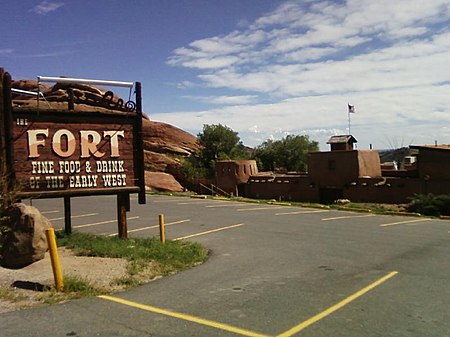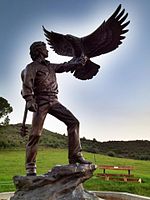Bradford House II (Site 5JF51) is a prehistoric rockshelter, 24 kilometres (15 mi) southwest of Denver. It is situated on land owned by the Ken-Caryl Ranch Master Association. It was excavated in the summer and fall of 1973 by the Denver Chapter of the Colorado Archaeological Society. The excavations found several cultural features and recovered thousands of chipped stone artifacts, dozens of ground stone artifacts, a few ceramic sherds, bone tools, and faunal remains. The site was used by prehistoric groups during the Middle and Late Archaic periods, as well as the Early Woodland, and Middle Woodland periods. This is a span of 4,500 years.
Bradford House II is located in the Ken-Caryl Valley. The Front Range foothills to the west and the Lyons and Dakota hogbacks to the east frame the valley. An abundance of archaeological sites, attests to the valley's attraction for the earliest inhabitants of the area. They frequented the area for its abundant resources, including shelter under the many bedrock monoliths scattered across the valley, lithic materials for chipped stone tools, and edible plants and animals.
West of the valley, the arkosic sandstones of the Pennsylvanian Fountain formation lie unconformably upon uplifted Precambrian metamorphic rocks of the Front Range (Rathbun 1997:21) . Although mostly covered by recent to pre-Wisconsin alluvium, the Fountain formation forms southwest facing escarpments, or monoliths, with undercut shelters or caves (Rathbun 1997:21), many of which were inhabited by prehistoric peoples. The elevation of the site is approximately 1878 m (6160 ft.) above mean sea level. Elevations surrounding the site range from about 1828 m (6000 ft.) in the Dutch Creek water gap to 1992 m (6536 ft.) on the highest point of the Dakota hogback ridge.
The valley has a sunny, mild, and semiarid climate that has neither the extreme cold of the higher elevations to the west nor the hot summer afternoons of the eastern plains (Tate 1997:15). A south-facing rock shelter like Bradford House II absorbs a great deal of solar radiation, further mitigating the winter cold. Precipitation is moderate, averaging 15 to 18 inches, and winter snows melt quickly (Tate 1997:17) with frequent down slope (chinook) winds.
The valley consists of various grasses and forbs. The surrounding hogbacks and foothills support a pine-Douglas fir vegetation community. The recovery of floral materials from Bradford House II and other archaeological sites in the valley (Johnson 1997:Table Gl) indicates that local plants such as sunflower, wild plum, acorn, and chokecherry were gathered and used by prehistoric peoples. Many animals, including elk, mule deer, and occasional Big Horn sheep, as well as a variety of carnivores, rabbits, rodents, birds, amphibians, reptiles, and fish are found in the hogbacks and foothills. Unworked animal, mostly mammal, bone was found in abundance in the Archaic and Early Ceramic levels (Johnson and Lyons 1997a:49, Table 6). Mule deer dominates the assemblage, followed by elk, bison, and rabbit, with little change in dietary preferences from the earlier to later time periods. Several bone tools (awls, beads, reamers, bone scrapers, and bone drills) and antler flakers were recovered from all cultural levels in the site (Johnson and Lyons 1997a) .







